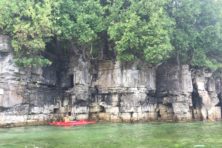Door County News: Group Looks to Expand Bike Options
- Share
- Tweet
- Pin
- Share
Biking is as popular as ever on the Door Peninsula, and the Door County Silent Sports Alliance (DCSSA) is anxious to help it grow more.
Bike lanes and trail access have become primary attractions for travelers and those looking to relocate and buy a new home. Trail proximity is now one of the top determinants in the purchasing decisions of home-buyers, and the nation’s most bike-friendly community’s all rank high on the lists of best places to live.

The Silent Sports Alliance hopes to spread this message in DC.
The DCSSA hopes to nudge Door County in that direction. The group is communicating with individual municipalities to raise awareness of bikers concerns and to try to get bike paths and lanes incorporated into short and long-term planning efforts.
“We want to try to get towns and villages to think about including it in their plans and budgeting,” said Brian Merkle, a DCSSA member who also sits on the board of the Town of Gibraltar.
Merkle, owner of Nor Door Sport and Cyclery in Fish Creek, said they hope to convince several Northern Door municipalities to set aside dollars to put toward a comprehensive bike plan that would link the villages.
“Getting municipalities to work together would lessen the cost for each of them versus doing their own plan,” he said.
The alliance sent the existing county bike plan to the Bicycle Federation of Wisconsin (BFW), a non-profit organization whose mission is “to make Wisconsin a better place for bikers,” to review it.
“The intent is to get a group that’s more familiar with it to give us better ideas,” Merkle said.
After a preliminary review of the plan the federation said it could use another look and possible revisions. Merkle and DCSSA President Bob Dickson said there’s no better time to take a new look with Door County working on its Comprehensive Plan, and with significant highway improvements on the horizon for Sister Bay and Egg Harbor it’s only fitting to examine how improved bicycle traffic can fit in to the developments.
The county’s current bike plan basically consists of signage and maps, but with bike traffic increasing, bike enthusiasts believe it’s time to make biking safer and easier on the peninsula.
“Sister Bay has the first leg in with the path they put in a few years ago,” Merkle said. Now he would like to see Fish Creek and Ephraim link up with their neighbor to the north through a combination of shoulder bike lanes or separate paths similar to Sister Bay’s.
“It could just mean widening the shoulders on some roads, better signage, or painting lanes,” Merkle explained. Eventually it could stretch to Egg Harbor, where Dickson is talking to officials about spreading the idea and joining the effort to get a comprehensive bike plan, which is a necessity if the county wants to go after a piece of the millions of dollars in federal and state grants available to build and improve biking infrastructure.
Katrine Lehrer-Brey, Lead Planner for BFW, said it will only help to plan in advance.
“It’s required for the grant money,” she explained, “but those often require a 20 percent local match as well. So if you do the plan, you can start setting aside money in your budget for projects to be prepared.”
Dickson said they want to include the parks in the planning as well. By getting the conversation started on many fronts, he hopes the concerns of bikers and other users will be on the table when decisions are made on how to proceed with projects. For instance, if the county has a road slated for resurfacing that’s also on the bike plan, adding width to the shoulder for bikes could be considered and grant funding could be sought.
With offices in Milwaukee and Madison, the BFW works with local groups around the state to improve awareness, education, and often consults in the planning process for communities looking to develop bike lanes and maps.
While creating a bike plan includes many factors, including traffic counts, crash data, and state regulations, Lehrer-Brey said it’s not a strictly scientific approach, as they talk to local bikers to get their input and favorite routes.
“A comprehensive bike plan is really about the coordination of efforts,” Lehrer-Brey explained. “To get people, who otherwise might not work together, in the same room so it doesn’t have to be a completely separate, costly plan. And it also helps to bring the municipalities together to work cooperatively.”
She said communities generally look at bike plans from one of two camps – urban areas where commuter-focused plans are desired, and more rural areas where the paths are geared toward recreation and scenic desires. Door County falls into the latter category. A plan connecting Fish Creek to Sister Bay might include an off-road path through Peninsula State Park to separate bikers from the high-speed traffic of Highway 42 between the villages, with on-road lanes or markers through villages to take riders into commercial centers. A stretch through north Ephraim could be completed with a slight widening of shoulders with new signage.
The benefits of improving biking infrastructure are multi-faceted, highlighted in a 2004 Governor’s report on the Economic Impact of Bicycling in Wisconsin. The report said safety is a big factor, but improving bike routes also enhances a destination’s tourism possibilities, gives residents easy opportunities for exercise, and produces energy savings over vehicle transportation. Studies show it even helps attract a healthy, younger workforce.
“Anyone with an active lifestyle is going to look for those communities with trails and biking opportunities,” Lehrer-Brey said, and explained how some areas even use it as a way to brand themselves. “Jefferson County recently worked on a plan where they have signage at the entry points of the county as an announcement that the community is bike friendly.”


